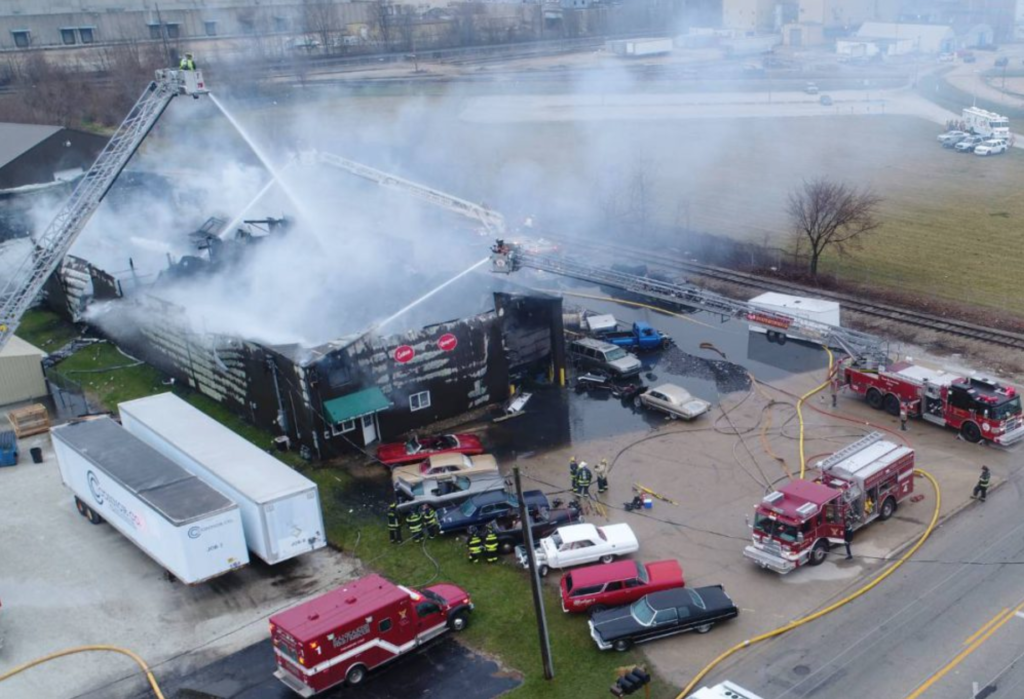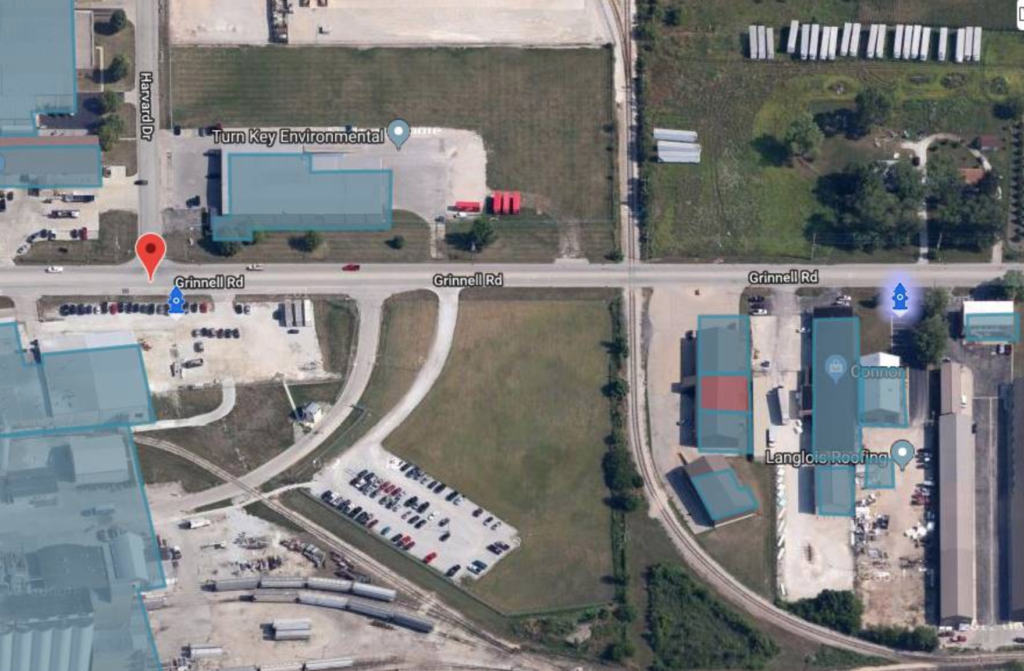By: Assistant Chief Michael Fronimos
Wytheville Fire & Rescue Department
On April 5th, 2019, at just after 5 am, the Kankakee FD was dispatched to 1590 Grinnell Rd. for the activated fire alarm. Shift Commander Capt. Eric Boness called in service and responded to the address, which sat in a heavy industrial section of the City of Kankakee.
While en route, Capt. Boness received notification that police officers on the scene reported heavy smoke coming from the structure and confirmed a working fire.
Capt. Boness arrived on scene approximately 5 minutes post-dispatch and established his command.

Capt. Boness also noted exposures on the C side (similarly built structure, 30’ away) and B side (130’ long single-story carport, 20’ away).
Based on his size-up, Capt. Boness immediately requested a box alarm and then upgraded to a second alarm within minutes due to a rapid change in fire conditions. These extra alarms were filled from surrounding mutual aid departments.
Most importantly, Capt. Boness was unfamiliar with how the 10,000 square feet of 1590 Grinnell Rd. was utilized. Exterior signage indicated that the building may be occupied by three separate tenants, but not where separations or firewalls were located, or if there were even firewalls in place. Capt. Boness was also not aware of the present fire load or what the current tenants stored on site as part of their businesses. This presented a number of tactical questions:
After assigning his initial fire attack, Capt. Boness opened FlowMSP and viewed the fire preplan previously created for 1590 Grinnell Rd.
With that simple act, his information blind spot virtually disappeared.

The simplistic beauty of FlowMSP is the ability to see the information an incident commander needs most. Instead of reading text descriptions of a building, or trying to decipher hand-drawings, FlowMSP shows the user a real-life image of the building, overlaid with all the critical pre-plan information needed to formulate an attack, plan a rescue or create a defensive stand.
That morning, in his command vehicle parked 300 feet from 1590 Grinnell Rd., Capt. Boness opened FlowMSP and was able to immediately see exactly where each business separation was located. He could see which windows belonged to which compartment and which doors would access which business. Taking advantage of Flow’s information sections, he saw what business owned what compartment, giving him information about their possible fire loads. Finally, he noted that 1590 Grinnell Rd. was constructed with a wooden open-web truss roof.
Now, instead of looking at the dark, smokey building in front of him and trying to decipher construction characteristics, Capt. Boness viewed daytime satellite imagery of the building. More importantly, he also viewed daytime images of each side of the building, taken by Kankakee’s own firefighters.



As every seasoned incident commander knows, the command post of a multiple alarm fire can quickly bog down with too many chiefs and too much verbal chatter. The catch-22 is always the need to pass orders without crowding the command post or tying up the radio with lengthy orders. Imagine being able to issue orders in five words or less…
With FlowMSP, that’s exactly what happened.
As second-alarm officers arrived at 1590 Grinnell Rd., Capt. Boness used the overhead imagery in FlowMSP to show them what he wanted. Quite simply, he was able to put his finger directly on the spot he wanted the second-due tower ladder. That officer looked at the spot on the image, confirmed some landmarks and relayed the orders to the incoming truck. Very few words were required, and the truck set up exactly where Capt. Boness intended.

Fire hydrants are highlighted on FlowMSP’s satellite maps in the NFPA colors indicating volume. Also, based on the size of the building pre-planned, FlowMSP will automatically highlight the required hydrants upon receiving the CAD dispatch information.

At 1590 Grinnell Rd., these hydrants were on the map and highlighted, meaning Capt. Boness only needed to show his water supply officer which hydrant he wanted. With that information, and because the officers were looking at satellite images of the area, they were able to easily determine the best approach and supply locations. All it took was a look at FlowMSP and very few words. A potentially complicated task cut down to a quick exchange of information.
As the situation at 1590 Grinnell Rd. progressed, and more mutual aid officers arrived, Capt. Boness assigned sector officers. Before assuming control of their sector, each sector officer reported to the command post and viewed daytime images of their sector on FlowMSP. Even with a quick glance, sector officers could identify windows, doors, hazards, and construction characteristics.
Without FlowMSP, these sector officers would have had to decipher this information by examining a 200’ long building in the dark, costing valuable time and greatly increasing the chance for an error.
When the utility company arrived to secure the utilities on 1590 Grinnell, Capt. Boness did not have to guess or even ask where the utilities were located. As part of a complete FlowMSP pre-plan, all utility shut offs are visibly highlighted on an image of the structure, and 1590 Grinnell Rd., was no exception. With just a glance, the utilities were identified and their location noted.
Much like other facets of the operation, Capt. Boness then showed the utility worker the images, and they were able to walk directly to the shut offs; significantly cutting down the amount of time a non-firefighter spent walking around an active fire scene, as well as ensuring the utilities were secured in the shortest amount of time.
Large-scale fires, or ‘surround and drowns’ present a number of difficulties that IC’s have to cope with, and in this case, with three tower ladders flowing at capacity, there were concerns with runoff.
Without FlowMSP, firefighters would have to be tasked to investigate each building being threatened by runoff and report its contents to the IC. Once the IC has all the necessary information decisions can be made. Considering the size of many industrial buildings, that could present a significant information lag. And with 6000 gpm flowing into the fire building, time can mean a hazard developing far faster than mitigation can be established.
On April 5th, however, Capt. Boness just turned to FlowMSP. Thanks to the diligence of Kankakee’s pre-plan firefighters, a FlowMSP pre-plan existed for every structure surrounding 1590 Grinnell Rd. Each plan had business information, construction type, possible contents, and owner contact information. Information lag eliminated.
Fire Department incident commanders know that no plan comes together without good information, be it from what the IC can see for themselves, what they are told, or what is available in good pre-plans. Information is the tool the IC needs to maestro their orchestra.
In the case of 1590 Grinnell Rd., Capt. Boness faced a lot of unknowns in the early stages of the incident and suffered from a number of information blind-spots that could have significantly altered his tactical plans. Gathering that information would have taken time, resources and may have put firefighters at unnecessary risk.
By utilizing the pre-plan created in FlowMSP, many of those blindspots no longer existed.
Instead of a large, dark warehouse with visible fire burning in an unknown size compartment with an unknown fireload, Capt. Boness had a fire burning in the center tenant space of a 50’ x 200’ warehouse with a reasonably-known fire load. He knew his setbacks, roof construction, hazards, and hydrant locations, all at once.